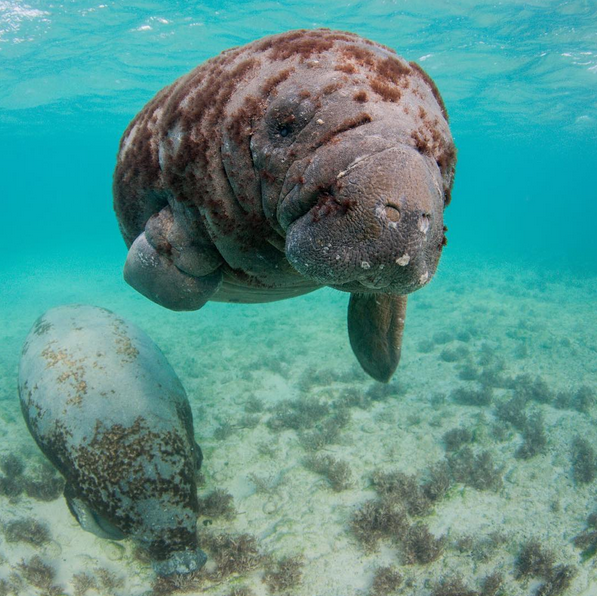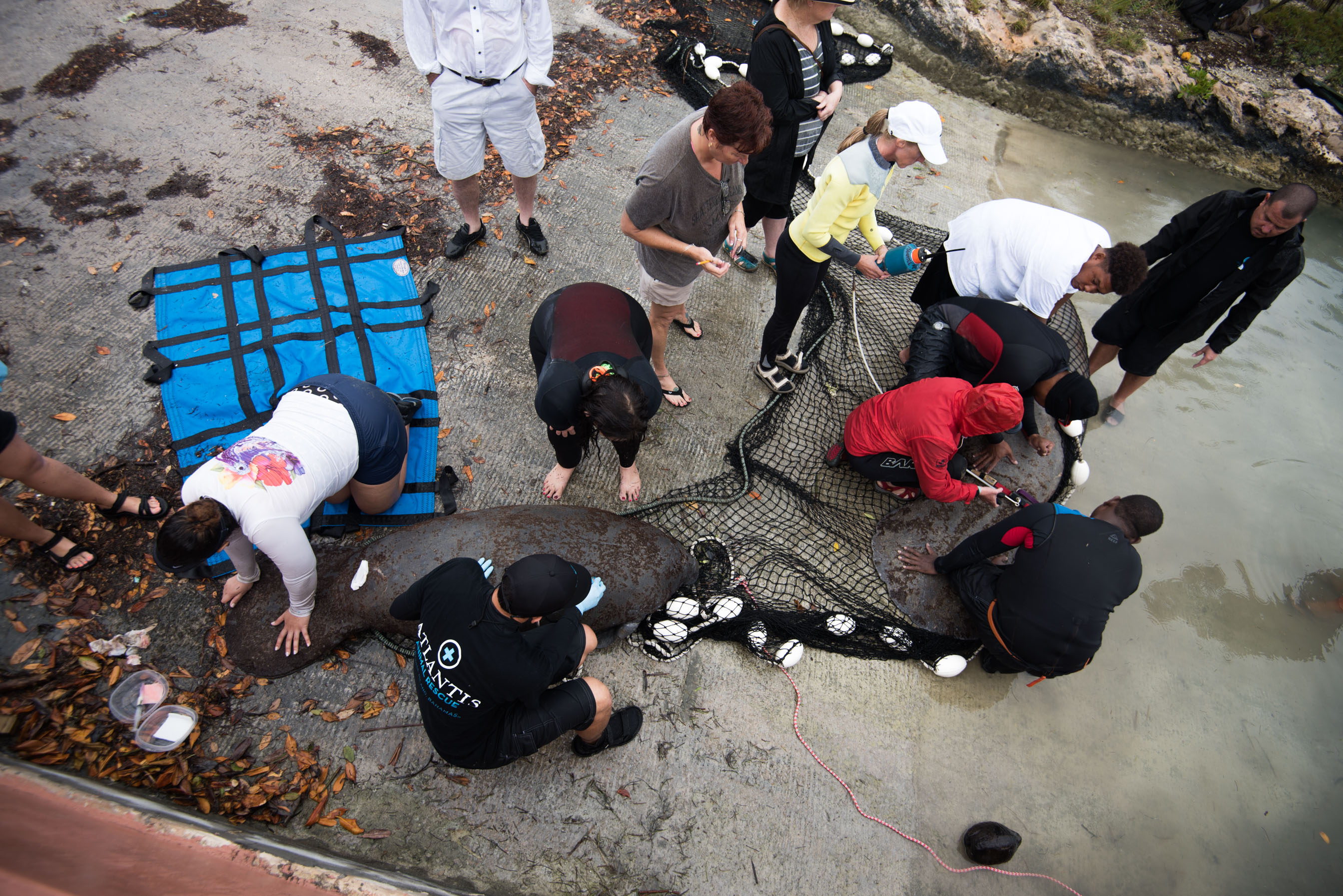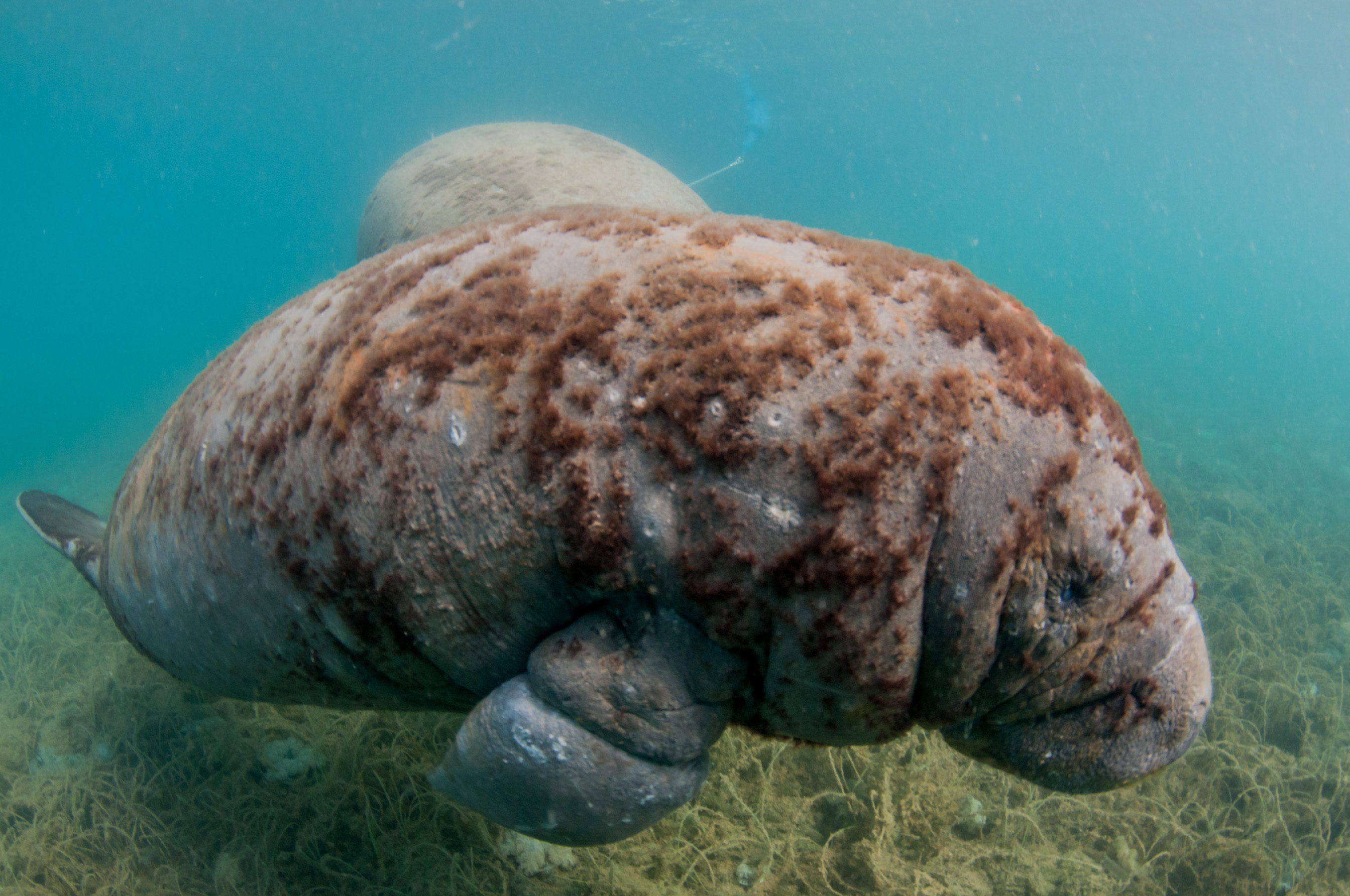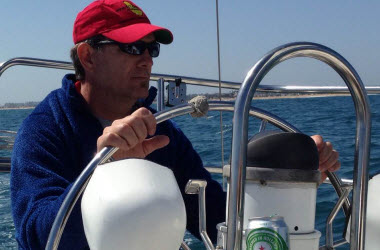March 04, 2016
I’m working now on Eleuthera Island in the Bahamas, just south of the world famous Harbour Island, where I hear billionaires are buying out millionaires.
A few days ago, while making breakfast and letting the dog out, I saw an odd shape appear at the water’s edge in front of my house.
I also spotted an odd-looking head at the surface of the water and then duck below.
I only had a brief look, but quickly surmised it was a manatee. Forgoing my freshly brewed coffee, I donned my fins and mask grabbed my camera and ran down my slippery stairs in to the water.
I was right—and wrong. It wasn’t one manatee. It was two, a mom and her calf. The little one came straight up to me, and the mother appeared to be relatively at ease with my presence.
 For the next hour I swam with them. I photographed as they ate sea grass and I listened to their quiet but just-audible clicks and squeaks.
For the next hour I swam with them. I photographed as they ate sea grass and I listened to their quiet but just-audible clicks and squeaks.
Later in the day, I was chatting with a colleague about the experience and he mentioned the pair were well known and had names—the mother was Gina and the baby was Sayle.
But he told me there was a problem—the baby had fishing line wrapped around her right flipper. I quickly reviewed my images to see if I could spot it, and sure enough there was a distinct line a third of the way down her flipper and, compared to the left, it was very swollen. The fishing line was barely visible, but its presence was taking its toll. Manatee flippers are critical.
First, manatees use their flippers to “walk along the ocean floor” while they dig for plants (they are herbivores). When they find food, the flippers are used to scoop the vegetation toward the manatee's lips.
To survive, the flippers have to be in good working order. Besides, the swelling on Sayle’s flipper indicated she might be in pain.
I emailed the pictures to the local research group, the Bahamas Marine Mammal Research Organization (BMMRO), and let them know where I had encountered the manatees as well as the time of the sighting.
They replied that in a few days they would be trying to capture the baby to remove the fishing line and hopefully save the flipper. I had to join them.
So on the appointed day I met up with my friend Shane and we took a ferry across to Spanish Wells, where the manatees were last spotted. We soon met up with team that included the researchers from BMMRO and a small army from the Atlantis Resort in Nassau, including their staff veterinarians.
The members of this team had all performed manatee captures before, and they had the know-how on how to handle an adult manatee, which can weigh over 1,500 pounds.
 We boarded two boats and set out on the search. A local woman who has been interacting with the manatees was also brought in to help.
We boarded two boats and set out on the search. A local woman who has been interacting with the manatees was also brought in to help.
She had come to know the pair well, and would swim with them both almost every morning. So if anyone could coax the two into a position where they could be safely captured, it was her.
We located the pair in a dead-end waterway by some boats. We hunted for a suitable boat ramp—one that could be closed-off with a net. It had to be in a deep enough area to coax them in, yet a gentle slope that would allow our team to haul the two mammals out of the water.
There was a suitable boat ramp nearby, but it would require our two boats to close off the entrances to other water ways. We also needed a local to swim and lead the manatee to where we wanted them, about a third of a mile from where we’d found them.
Once we had persuaded them to head to our preferred location, we had the delicate task of closing off the exit of the ramp with a large net, all while being extremely quiet and calm.
After a couple of false starts with the manatees clearly indicating they sensed danger, we got the area and the manatees contained. Then it was time to haul the net in, capture the two, and quickly bring them out of the water. We also needed to separate the two because the mom could easily crush the baby as she tried to power her way free.
 We got them both out and separated and it was time to get to work. I was one of two people to put our body weight on the baby, to keep her from hurting herself on the cement. It was her natural instinct, of course, to try and flap her body back to the water.
We got them both out and separated and it was time to get to work. I was one of two people to put our body weight on the baby, to keep her from hurting herself on the cement. It was her natural instinct, of course, to try and flap her body back to the water.
A handful of others did the same to the mother. Finally, they both calmed down.
A group of us became the breath-counting team to make sure each breath was counted and its time was recorded. And then the vets got to work.
The tangled-up line was probably 100-lb. test and it was wrapped three times around Sayle’s fin. It had cut its way into her flesh, up to an inch deep in places.
The vet seemed to think the bones were fine and that there was still good blood flow to the tip of the flipper.
After a good clean-out of the wound, and application of antibiotic ointment, it was time to get some measurements to get a weight estimate.
This weight was used to calculate the right size dose of antibiotics to give the baby’s immune system some added strength to fight infection.
Blood work was done on both the mom and baby to later evaluate their overall health. A satellite tag was attached to the mom. As a result, we can now follow her whereabouts.
 (So can you, by logging into the Facebook page of the BMMRO. The frequently update where Gina and Sayle are feeding.)
(So can you, by logging into the Facebook page of the BMMRO. The frequently update where Gina and Sayle are feeding.)
All in all, it was a very successful mission.
I’m so glad I looked up from my breakfast preparations when I did.
It was a thrill to participate in the team effort. It was truly amazing to watch the variety of skill sets that came together to address Sayle’s needs. With mammals of that size, this was no job for just a few individuals.
It was us humans who created her unfortunate situation. It was up to us to fix it.
And I’m so glad we did.
By the way, the name of our island (Eleuthera) is derived from Greek.
It means “free.”

